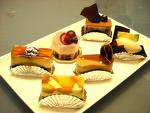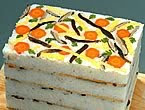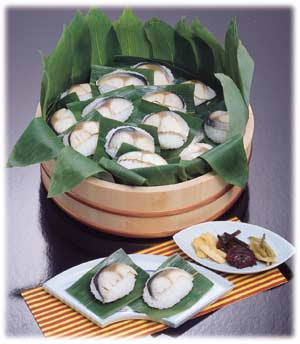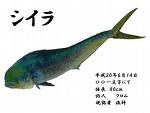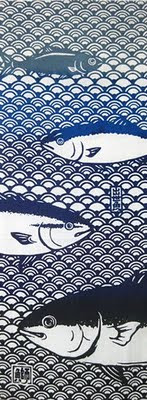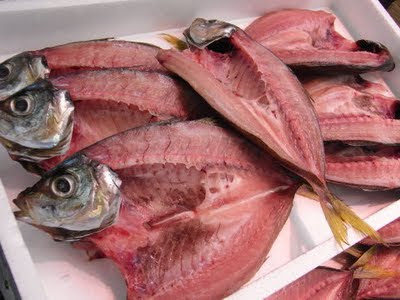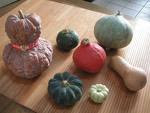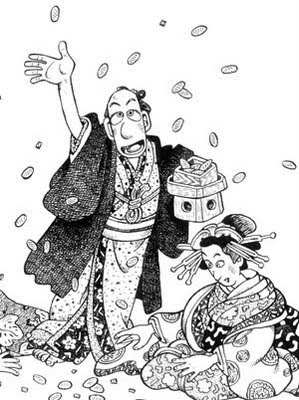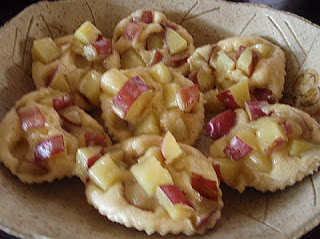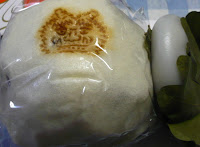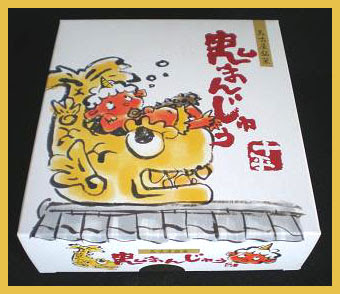[ . BACK to WORLDKIGO TOP . ]
::::::::::::::::::::::::::::::::::::::::::::::::::::::::::::::::::::::::::::::::::::::::::::::::::::
Thunafish, tuna (maguro)
***** Location: Japan
***** Season: Various, see below
***** Category: Animal
skipjack katsuo bonito see below
*****************************
Explanation
kigo for all winter
Tuna, maguro 鮪 (まぐろ)
shibi しび tuna
(
shibi is also the name of a temple roof decoration, see German below.)
"black tuna", bluefin tuna, kuromaguro 黒鮪(くろまぐろ)
... Thunnus thynnus
"real tuna", hon maguro 本鮪(ほんまぐろ)Atlantic bluefin
binnaga maguro 鬢長, ビンナガマグロ Thunnus alalunga, "White tuna"
kihada キハダマグロ Thunnus albacares. Gelbflossen-Thunfisch
koshinaga コシナガ / 腰長 Thunnus tonggol. Longtail tuna
mebachi めばち / 眼撥 Thunna obesus. big-eyed tuna. großäugiger Thunfisch
minami maguro ミナミマグロ Thunnus maccoyii
taiseiyoo maguro タイセイヨウマグロ Thunnus atlanticus
boat for fishing for tuna, magurobune 鮪船(まぐろぶね)
fishing for tuna, maguro tsuri 鮪釣(まぐろつり)
net for tuna, maguro ami 鮪網(まぐろあみ)
maguronabe 鮪鍋(まぐろなべ)hodgepodge with tunafish
often leek (negi) is added to make a
negima nabe 葱鮪鍋(ねぎまなべ)
This was a speciality of Edo. the MA in the name refers to the MAguro fish.
. . . CLICK here for Photos !
:::::::::::::::::::::::::::::::::::::::::::::::::::::::::::::::::::::::::::::::::::::::::::::::::::
kigo for all spring
meji めじ small tuna, young tuna
komeji 小めじ(こめじ), meji maguro めじまぐろ . めじ鮪
. . . CLICK here for Photos !
junger Thunfisch
:::::::::::::::::::::::::::::::::::::::::::::::::::::::::::::::::::::::::::::::::::::::::::::::::::

Tuna
are ocean-dwelling carnivorous fish in the family Scombridae, mostly in the genus Thunnus. Tuna are fast swimmers—they have been clocked at 70 kilometres per hour (43 mph)—and include several warm-blooded species. Unlike most fish, which have white flesh, tuna flesh is pink to dark red, which could explain their odd nick-name, "rose of the sea." The red coloring comes from tuna muscle tissue's greater quantities of myoglobin, an oxygen-binding molecule. Some of the larger species, such as the bluefin tuna, can raise their blood temperature riri above water temperature through muscular activity. This ability enables them to live in cooler waters and to survive in a wide range of ocean environments.
A remarkable aspect of Thunnus physiology is its ability to maintain body temperature above than that of the ambient seawater.
The Thunnus genus includes 8 species:
Albacore, Thunnus alalunga (Bonnaterre, 1788). binchoo maguro
Yellowfin tuna, Thunnus albacares (Bonnaterre, 1788). kihada
Blackfin tuna, Thunnus atlanticus (Lesson, 1831).
Southern bluefin tuna, Thunnus maccoyii (Castelnau, 1872).
Bigeye tuna, Thunnus obesus (Lowe, 1839). mebachi
Pacific bluefin tuna, Thunnus orientalis (Temminck & Schlegel, 1844).
Northern bluefin tuna, Thunnus thynnus (Linnaeus, 1758).
Longtail tuna, Thunnus tonggol (Bleeker, 1851).
Canned tuna was first produced in 1903, quickly becoming popular. Tuna is canned in a variety of edible oils or in brine.
© More in the WIKIPEDIA !
The names for the small fish, too small to take out
albacore - tonbo, tombo
bluefin - meji
big eye - daruma
yellowfin - kimeji, ki meji
. . . CLICK here for Photos !: mebachi daruma
ちいさいめばちは「だるま」
. WASHOKU
Fish called DARUMA
:::::::::::::::::::::::::::::::::::::::::::::::::::::::::::::::::::::::::::::::::::::::::::::::::::
The most important harbors for maguro are in Ooma 大間, Aomori, and in Misaki 三崎, Kanagawa 三崎まぐろ.
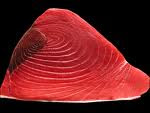
Ooma maguro 大間まぐろ Maguro from Oma harbour
often fished with one line in the rough sea toward Hokkaido
Tuna auctions at Tsukiji Market in Tokyo
Tsukiji, the big fish market in Tokyo 築地市場, Tsukiji shijoo
Oroshi hocho, oroshiboochoo
( おろし包丁, "wholesale knife") and
hancho hocho (半丁包丁, "half-tool knife")
are extremely long, highly specialized knives used in Japan to fillet tuna and other large fish.
The hancho hocho is also sometimes called a maguro kiri ( マグロ切, "tuna-cutter").
. WASHOKU
Japanese knives
:::::::::::::::::::::::::::::::::::::::::::::::::::::::::::::::::::::::::::::::::::::::::::::::::::
Dishes with Maguro 鮪料理
maguro ryoori
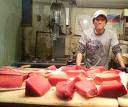 tsuna ツナ tuna
shiichikin シーチキン "sea chicken" white tuna
tsuna ツナ tuna
shiichikin シーチキン "sea chicken" white tuna
. . . CLICK here for Photos !
 akami
akami 赤身 top loin of Bluefin tuna
maguro chazuke マグロ茶漬け tuna on rice with green tea
. . . CLICK here for Photos !
Thunfisch-Stücke auf Reis mit grünem Tee übergossen
magurodon, maguro-don まぐろ丼 cooked rice with tuna on top
. . . CLICK here for Photos !
Schüssel Reis mit Thunfisch
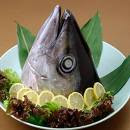 maguro kabuto
maguro kabuto マグロかぶと / マグロ兜 head of a tuna
speciality in harbour restaurants
maguro no oroshiae まぐろのおろしあえ
mit geriebenem Rettich angemachter Thunfisch
. . . CLICK here for Photos !
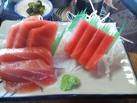 maguro sashimi
maguro sashimi まぐろ刺身 Sashimi with tuna meat
maguro sushi まぐろ 寿司
. . . CLICK here for Photos !
maguro suteeki まぐろステーキ Maguro-Steak
. . . CLICK here for Photos !
negima 葱鮪 dishes with leek and maguro
maguro negima まぐろねぎま
. . . CLICK here for Photos !
negitoro, negi-toro 葱とろ (ねぎとろ) Bluefin tuna belly and chopped green onion
served at the sushi bar
negitoro don ねぎとろ丼 served on rice
. . . CLICK here for Photos !
shiro maguro (白鮪) Binnaga orBincho (鬢長) "white tuna"
on sushi rice
toro とろ meat for sashimi

ootoro (大とろ) Otoro: fattiest portion of Bluefin tuna belly
toro (とろ) fatty Bluefin tuna belly
chuutoro (中とろ) chutoro : medium-fat Bluefin Tuna belly
yamakake 山掛け tuna on rice with grated yam
..... yamakake maguro 山掛けまぐろ
. . . CLICK here for Photos !
Thunfisch-Stücke auf Reis mit geriebener Jamswurzel
yokowa maguro ヨコワまぐろ meat from the ribs of very young bluefin tuna, not more than 3 kg of body weight. baby tuna, young tuna.
Served as sashimi in Fukuoka.
. . . CLICK here for Photos !
*****************************
Worldwide use
Germany
Thun, Thunfisch

Ein alter Name für Maguro ist in Japan
SHIBI 鴟尾; 鵄尾; 蚩尾, er stammt aus dem Chinesischen. Diese Bezeichnung hat sich übertragen auf die fischschwanzförmige Verzierung der Endziegel auf dem Dachfirst eineswichtigen Gebäudes, zum Beispiel Schloss oder Tempel. Dieser „Fischschwanz“ soll als Repräsentant der Gottheit des Wassers das Schloss oder den Tempel vor Brandgefahr schützen. Daraus hat sich dann auch der
shachihoko しゃちほこ Ziegel entwickelt, ev. auch allgemein der "Demon tile"
onigawara 鬼瓦.
Thunnus alalunga: der Weiße Thun
Thunnus albacares: der Gelbflossen-Thun
Thunnus maccoyii: der Südliche Blauflossen-Thun
Thunnus obesus: der Großaugen-Thun
Thunnus orientalis: der Nordpazifische Blauflossen-Thun
Thunnus thynnus: der Rote Thun
Thunnus tonggol: der Langschwanz-Thun
Mehr in der WIKIPEDIA !
:::::::::::::::::::::::::::::::::::::::::::::::::::::::::::::::::::::::::::::::::::::::::::::::::::::
. Yellowfin tuna (thamad)
Yemen
*****************************
Things found on the way
だるまマグロ Daruma Maguro
Lately sold at Tsukiji Fish Market in Tokyo for rather cheap.
メバチマグロの幼魚です. supposed to be the baby of a mebachi maguro.
Good for sashimi
. . . CLICK here for Photos !
*****************************
HAIKU and SENRYU
居酒屋に靄たちこむる葱鮪かな
izakaya ni kiri tachikomuru negima kana
at the local pub
mist is gathering -
tuna with leek
Inoue Aa 井上唖々 (1878 - 1923)
四代を生きて傘寿や葱鮪鍋
yondai o ikite sanju ya negima nabe
on my 80th birthday
I look back at four generations -
tuna hodgepodge
Machida Shigeki 町田しげき
 tuna hodgepodge
葱鮪鍋下町に闇にはかなり
tuna hodgepodge
葱鮪鍋下町に闇にはかなり
negima nabe shitamachi ni yami ni hakanari
tuna hodgepodge -
downtown is slowly
getting dark
Itoo Kango 伊藤完吾 Ito Kango (1972 - )
あたたかき葱鮪の湯気やぶしやうひげ
日野草城
たれかれの話となりし葱鮪かな
斎藤優二郎
一族の影の濃くなる葱鮪鍋
八木荘一
葱鮪鍋つつく合縁奇縁かな
清水基吉
葱鮪鍋もも引渡世難きかな
秋山夏樹
source : HAIKUreikuDB
*****************************
Related words
***** kajiki maguro 梶木鮪 (かじきまぐろ, 旗魚鮪) marlin
..... kajiki 旗魚 swordfish
Makaira mitsukurii
fishing for marlin, kajiki tsuri かじき釣り(かじきつり)
kigo for all winter
:::::::::::::::::::::::::::::::::::::::::::::::::::::::::::::::::::::::::::::::::::::::::::::::::::::
***** katsuo 鰹 bonito
skipjack tuna
Katsuwonus pelamis
katsu uo 勝つ魚
"fish to win" - its name was an auspicious one, therefore it was well loved in Edo.
. . . Katsuo and related kigo
kigo for all summer
Dried bonito pieces (katsuobushi 鰹節)
Sawachi food from Tosa 皿鉢料理 sawachi ryoori with bonito katsuo tataki
.......................................................................
first bonito, hatsu gatsuo, hatsugatsuo 初鰹 (はつがつお)
kigo for early summer


十二月の内 卯月初時鳥 -
Toyokuni 豊国
The first catch of the season.
First things were much loved in Edo and people payed high prices to get them, some were even first offered at a shrine before consumption.
. WKD : First Things .
目に青葉 山ほととぎす初かつお
me ni aoba yama hototogisu hatsu katsuo
green leaves to look at
hototogisu in the mountains
first Katsuo skipjack
Yamaguchi Sodoo 山口素堂 Sodo
(1642 - 1716)
He was a disciple of Matsuo Basho.
-
and a senryu in Edo - reflecting on this one
目と耳はいいが口は銭がいる
me to mimi wa ii ga kuchi wa zeni ga iru
for the eyes
and ears it is fine but
the mouth needs money
We can enjoy a lot for free in spring, but the first katsu fish is just sooo expensive.
- quote -
Thirty-six Views of the Pride of Edo -
The first bonito pick at Nihonbashi (Edo Jiman Sanjūrokkyō Nihonbashi Hatsu-gatsuo)
Painted by Utagawa Toyokuni III and Utagawa Hiroshige II 1864 (Genji 1)
This is a picture that truly shows the "pride of Edo", together with Nihonbashi, a symbol of the city of Edo, hatsugatsuo, the first bonito of the season much adored by the residents of Edo and their admiration was such that a senryū was composed,
Hatsugatsuo
to pawn one's wife for this
is a worthwhile exchange

Among the choicest of the hatsumono (first products of the season), bonito was loved the most by people in Edo. Especially from the Meiwa and Anei (1764-1781) to Bunka and Bunsei (1804-1830) when there was a bonito boom which drove up the price of tuna to startling levels.
According to the recordings of representative writer of the Edo period Nanpo Ota (pen name Shokusanjin), in the third month of 1812 (9th year of Bunka), 6 out of 17 of the bonito brought to the Nihonbashi fish market were delivered to the shogun household, 3 to a famous restaurant
Yaozen for the price of 2 ryo and 8 were handed to fishmongers and of these, one was bought by kabuki actor Utaemon Nakamura for the price of 3 ryo.
- source : library.metro.tokyo.jp -
. yaozen 八百善 Yaozen restaurant .
. senryuu, senryū 川柳 Senryu in Edo .
. . . . .
bonito in autumn, akigatsuo, aki gatsuo 秋鰹 (あきがつお)
soodagatsuo 宗太鰹 (そうだがつお ) frigate mackerel
marudooda 丸宗太(まるそうだ)"round Soda"
hiresooda 平宗太(ひらそうだ) "flat Soda"
kigo for all autumn
Soda katsuo, Auxis thazard
. . . . .
. hatsugatsuo no shinku 初鰹神供 (はつがつおのしんく)
offering first bonito .
at shrine Hachimangu, Kamakura
with a hokku by Matsuo Basho about the hatsugatsuo from Kamakura
observance kigo for the New Year
.......................................................................

hatsugatsuo uri 初鰹売り first Katsuo vendor in Edo
The vendors started to come around in the fourth lunar month.
昼までの勝負と歩く初鰹
hiru made no shoobu to aruku hatsugatsuo
walking around till lunchtime
for victory or defeat -
first bonito
They took a risk like any street vendor, but their risk (shoobu) was rather small, since most Edoites would pay any sum to get this fish.
初鰹かついだままで見せている
hatsugatsuo katsuida mama de misete iru
the first bonito
shown while still carrying
the tubs on the shoulders
The vendors were so busy, they did not take the time to put their shoulder poles down and place the tubs on the ground.
あての有るようにかけ出す鰹売り
ate no aru yoo ni kakedasu katsuo uri
the bonito vendor
begins to run as if he knew
where he is heading
Still, they made their best business while just walking around, calling out their merchandise.
. senryu, senryū 川柳 Senryu in Edo .
 source : www5e.biglobe.ne.jp/~mitta/town
source : www5e.biglobe.ne.jp/~mitta/town
.......................................................................
- - - - - Matsuo Basho
鰹売いかなる人を酔すらん
katsuo uri ikanaru hito o yowasuran
A bonito monger -
What people does he charm
With his pitch?
Tr. Takafumi Saito
又越む佐夜の中山はつ松魚
mata koemu Sayo no Nakayama hatsugatsuo
I want to cross it again
this mountain pass of Sayo -
first katsuo skipjack
Tr. Gabi Greve
He had eaten skipjack before crossing this dangerous pass and now remembers this meal fondly.
koeru 超える to cross over a pass
MORE - hokku about
Sayo no Nakayama by
. Matsuo Basho 松尾芭蕉 - Archives of the WKD .
:::::::::::::::::::::::::::::::::::::::::::::::::::::::::::::::::::::::::::::::::::::::::::::::::::::::
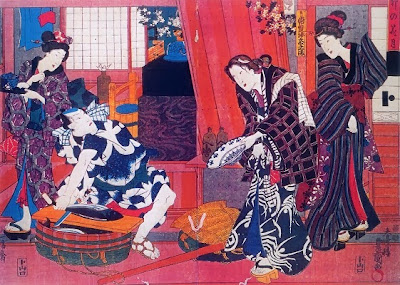 source : www.kabuki-za.com
source : www.kabuki-za.com

Utagawa Toyokuni 歌川豊国
長屋の住人が共同で買った鰹を魚屋が切り分けている図
A fish peddler cuts a katsuo for the ladies.
.......................................................................

Utagawa Toyokuni 歌川豊国 3rd.
伊勢参りと女魚売り A man on the Ise pilgrimage and a female fish peddler.
She carries a bandai 盤台 barrel with 鰹 Katsuo and awabi 鮑 abalones.
二代目坂東簑助の伊勢参り - He is Bando Minosuke
二代目岩井粂三郎の女魚売 - She is Iwai Kumesaburo
:::::::::::::::::::::::::::::::::::::::::::::::::::::::::::::::::::::::::::::::::::::::::::::::::::::
First tuna fish was the IKI 粋 of Edo!
There was even a kimono pattern in its honor.
katsuojima 鰹縞 Katsuo stripes
 CLICK for more photos !
. - - - Welcome to Edo 江戸 ! - - - .
CLICK for more photos !
. - - - Welcome to Edo 江戸 ! - - - .
:::::::::::::::::::::::::::::::::::::::::::::::::::::::::::::::::::::::::::::::::::::::::::::::::::::
*****
WASHOKU : FISH and SEAFOOD SAIJIKI
[ . BACK to DARUMA MUSEUM TOP . ]
[ . BACK to WORLDKIGO . TOP . ]
:::::::::::::::::::::::::::::::::::::::::::::::::::::::::::::::::::::::::::::::::::::::::::::::::::::

